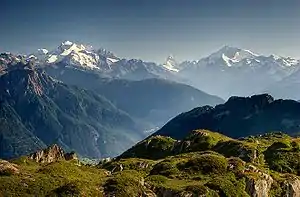List of highest mountains of Switzerland
This is a list of the highest mountains of Switzerland. This list only includes summits above 3,600 metres (11,811 ft) with a topographic prominence of at least 30 metres. Note that this list includes many secondary summits that are typically not considered mountains (in the strict sense of the term) but that are mainly of climbing interest. For a list of major summits only, without elevation cut-off, see List of mountains of Switzerland.

The International Climbing and Mountaineering Federation defines a summit in the Alps as independent, if the connecting ridge between it and a higher summit drops at least 30 m (a prominence/drop of 30 m, with the lowest point referred to as the "key col"). There are over 250 such summits exceeding 3,600 m in Switzerland,[1] all located in the High Alps, in five cantons:[Nb 1] Valais, Bern, Graubünden, Uri, and Glarus. All mountain heights and prominences on the list are from the largest-scale maps available.[2]
List
See also
- List of mountain lakes of Switzerland - highest lakes of Switzerland
- List of mountain railways in Switzerland - highest railways in Switzerland
- List of highest paved roads in Switzerland
Notes
- Out of 26
References
- Christian Thöni. "Directory of the mountains of Switzerland" (private site) (in German). Retrieved 2019-06-04.
- All mountain heights and prominences are from the 1:25,000 swisstopo topographic maps: "National Map 1:25,000" (official site). Wabern, Switzerland: Federal Office of Topography - swisstopo. 12 March 2019. Retrieved 2019-06-04.
- The three main sources for first ascent data are:
For the Western Alps; W.A.B. Coolidge, The Alps in nature and history, Methuen & Co, London, 1908.
For the Central Alps; Gottlieb Studer, Über Eis und Schnee: Die höchsten Gipfel der Schweiz und die Geschichte ihrer Besteigung, Volumes 1-3, Schmid & Francke, Bern, 1896-1899.
For the Eastern Alps: Die Erschließung der Ostalpen, Volumes 1-3, German and Austrian Alpine Club, Berlin, 1894.
Given are the years for the first recorded ascents. In many cases local people or surveyors made earlier ascents. In particular, chamois and ibex hunters are expected to have reached many summits. Years in italics indicate that it is known that an earlier ascent was made, for example by the presence of artifacts on top or the summit's prior use as a triangulation point.